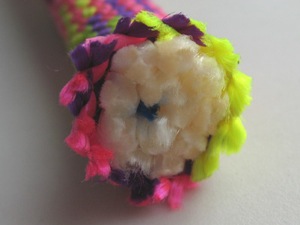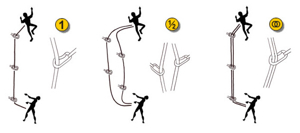The basic material from which the fibres of current climbing ropes are made of is a polyamide (PAD). Polyamide has a high tensile strength and elasticity. Tensile strength is up to 0,6 Gpa (1 Gpa is approx. 100kp/mm2). It melts at a temperature greater than 150°C. The climbing rope is made of the core (kern) and sheath (mantle). The core has the main load-bearing function, the sheath serves as a protection of the core, but in smaller part it also contributes to the total load-bearing capacity of the rope. The core is made of several braids, some of which are twisted clockwise and the same amount is twisted anticlockwise. This prevents spontaneous twisting of the rope. The colour of the sheath can vary. That is for example useful in winter, when the rope is covered with snow and thanks to its colour we can see it better. Colour loss of the sheath remind us that the rope is aging (or is possibly damaged by the chemicals). The aging colour change is not a rule with all ropes, some ropes do not loose their colour over the time, and yet they are already old and need to be discarded. Most manufacturers recommend discarding the rope after 5 years, even if it was not used. Some rope manufacturers stitch into the core a colour thread. Its colour is connected to a certain production year. This enables us to check the production year of ropes unknown to us, whose age we know nothing about (we’ll reach the thread by incising the end of the rope, afterward the end of the rope needs to be re-sealed). We need to know the rope manufacturer and know what thread colours they used for particular years. The rope aging is caused by disintegration of chains of polymers at the molecular level in their building structure, causing a loss of bond strength, and thus decreasing the strength of entire rope.

Surface of the climbing rope is treated with impregnation. This is, to a lesser extent, to protect the rope against mechanical effects, but mostly against water penetration. Impregnation is sometimes called water-repellent treatment of the rope. The ropes that are designed for winter use, or for use in rainy regions, are impregnated throughout its whole extent. Different manufacturers indicate such ropes on the labels as “Everdry”, “Superdry”, C.I.A.P, etc.
If we wanted to shorten the length of the rope by cutting, it is best to done by melting it with a hot object. If we are at home or somewhere in civilization the most proven method is the use of electrical solder. In the outdoor we can use a knife or nail heated over a gas stove or fire. During handling we have to be careful, the rope cannot get in touch with high temperature except of the place of cut.
Climbing rope cross-section – outer coloured sheath and inner light core, coloured inspection thread in the core to determine the year of manufacture (each year is assigned a colour).
Rope types
Climbing ropes are dynamic, i.e. they stretch under the load and absorb impact energy to a flexible stop. In addition, there are working and static ropes, which are either very little dynamic or they only serve to hold the weight and therefore almost do not stretch (mostly caving ropes). These working and static ropes cannot be used for fall arrest in mountaineering!!!
Climber can use only one climbing rope, literally – have one strand of the rope. Then we are talking about one strand rope. Or we may have two ropes, again meant literally – when two strands of rope run from climber we talk about two-strand rope. One-strand ropes are single ropes (approx. 10mm diameter). Two-strand ropes are either half ropes or double ropes (twins). Therefore we have 3 types of ropes.
- Single rope, so called “single”
- Half rope, so called “half”
- Double rope, so called “twins”

Continued in the book >>

